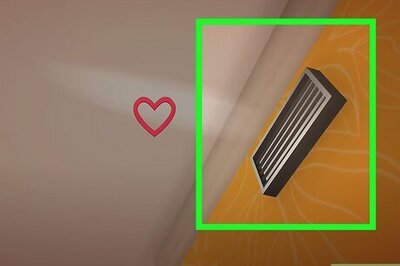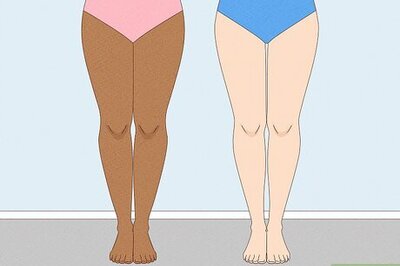
views
How to Clean a Top Loading Washer with Bleach
Make sure the washing machine is completely empty. Before you start cleaning your washer, make sure that there are no clothes in the drum and no leftover detergent or fabric softener in the dispensers.
Choose the largest, longest, and hottest cycle settings. If your washer has a “clean” or “maintenance” setting, you can simply select this cycle, explains house cleaning professional James Sears. It will automatically select the right load size and temperature for cleaning. If your washer doesn’t have a cleaning cycle, manually select the largest load setting, the hottest water temperature, and the longest cycle option, then press “start.”
Allow the washer to fill with water, then add 4 cups (946 mL) of bleach. Once the washer has filled up with water, pour 4 cups (946 mL) of liquid chlorine bleach directly into the drum. Bleach is a powerful cleaning agent that eliminates germs, mildew, and dirt, so it’s a great choice if you’re hoping to thoroughly disinfect your washer. If you prefer, you can use 4 cups (946 mL) of hydrogen peroxide instead of bleach.
Let the washer agitate for 1 minute, then pause the cycle for 1 hour. Allow the wash cycle to agitate for about 1 minute, so that the bleach gets thoroughly mixed into the water. Next, pause the cycle and open the lid of the machine. Allow the bleach solution to sit for 1 hour, so that your machine gets fully cleaned and disinfected.
Allow the washer to run through its complete cycle. After an hour has passed, close the lid and resume the wash cycle. Let the washer run until the cycle is fully completed and the water has drained out.
Clean the detergent and fabric softener dispensers. This process will look a bit different depending on whether your dispensers are removable or not. Here’s how to clean each type: For removable dispensers: Fill your sink or a bucket with hot water, then pour in 1 cup (236 mL) of distilled white vinegar. Remove the dispensers from your washer and place them in the vinegar solution to soak for 15 minutes. Afterwards, remove the dispensers and use a toothbrush to scrub away any leftover gunk or residue. Put the dispensers back in their places in your washer. For fixed dispensers: Heat up 1 cup (236 mL) of white vinegar on the stove or in the microwave, then pour the hot vinegar into the dispensers. Allow it to soak for 15 minutes to remove residue. If any gunk remains afterward, use a toothbrush to scrub it off.
Clean the lint filter. Many top loading washing machines have lint filters just like dryers do, although some newer models may not. House cleaning professional Chris Willatt explains that this filter can easily become clogged with lint and old laundry detergent residue, so it’s important to clean it if your machine does have one. Here’s how: Start by removing the filter. It should either be located along the top rim of the tub or inside the center agitator. If you can’t find it in either of these places, check near the water pump or at the end of the drainage hose. Next, fill your sink or a bucket with hot water and 1 cup (236 mL) of vinegar. Submerge the filter in the vinegar and water solution and allow it to soak for 15 minutes. Scrub the filter with a toothbrush to remove any gunk or residue. If your filter was in the center agitator, dip the toothbrush in the water and vinegar solution and scrub the inside of the agitator as well. Replace the lint filter. Note: Some lint filters may not be removable. If yours isn’t, use a damp microfiber cloth to wipe away trapped dirt and lint, then scrub the mesh with a toothbrush dipped in heated white vinegar.
Run one more cycle with hot water and 4 cups (946 mL) of vinegar. Start by letting the washer fill up with hot water, just like you did with the first bleach cycle. Next, pour 4 cups (946 mL) of white vinegar directly into the drum, and let the washer run through its complete cycle.
Clean the outside of the washer with a microfiber cloth. Fill a spray bottle with warm water, then add in a few drops of dish soap to make a cleaning solution. You can also fill the spray bottle with equal parts warm water and vinegar instead, if you prefer. Spray your cleaning solution onto the exterior of the machine, the buttons and dials, and the gaskets. Wipe all of these areas down with your microfiber cloth. And that’s it! Your machine should now be fresh, clean, and ready for your next load of laundry.
How to Clean a Top Loading Washer with Vinegar and Baking Soda
Select the longest and hottest settings and start the cycle. If your machine has a “clean” or “maintenance” option, choose this setting. If it doesn’t, manually select the longest and largest cycle settings, as well as the hottest water temperature. Press “start,” and let the washer fill up with water.
Add 4 cups (946 mL) of white vinegar, and let it agitate for 1 minute. Once the machine is filled up with water, professional cleaner Ashley Matuska recommends pouring 4 cups (946 mL) of vinegar directly into the drum. Allow the cycle to run for about 1 minute, so that the agitator can mix the vinegar into the water thoroughly.
Pause the cycle and allow the vinegar solution to soak for 1 hour. This gives the vinegar enough time to remove gunk, detergent residue, germs, and mildew.
Let the machine run until the rinse cycle starts. The water and vinegar solution will drain out completely, and when the rinse cycle begins, the machine will start to fill up with clean water again.
Pour in 1 cup (272 g) of baking soda. As the rinse cycle starts, add in 1 cup (272 g) of baking soda. Allow the washer to finish the rest of its cycle completely.
Clean the dispensers, gaskets, lint filter, and exterior of the machine. Wash these components according to the instructions listed above. Once everything is thoroughly cleaned, leave the lid open to make sure the machine dries completely.
How to Clean a Top Loading Washer with Commercial Washer Cleaner
Follow the instructions on the package of the washer cleaner. There are several commercial washing machine cleaners on the market that you can use instead of cleaning agents like bleach or vinegar. Some are in liquid form and others are tablets, and different products may require different cleaning processes, so be sure to follow the instructions listed on the product you’ve purchased. After cleaning the interior of your washer, clean the dispensers, gaskets, and exterior of the washer according to the instructions above.
How often should you clean a top loading washing machine?
Clean your top loading washing machine twice per year. For most machines that see a regular amount of use, a thorough cleaning once every 6 months should be enough, says Matuska. She explains, however, that there are a few circumstances that would require more frequent cleanings. If you use your machine super often, live in a very humid area, or have hard water, you may want to wash your machine once every 3 months, instead.
Tips to Keep Your Top Loading Washer Clean Longer
Leave the lid open after washing a load of laundry to prevent mildew. “The best thing you can do is preventative maintenance,” explains Willatt. For example, “Always leave [the lid] a little bit cracked open, so that you don’t give the water time to sit in there and create mildew,” he says.
Don’t use too much detergent or fabric softener. If you’re trying to get your clothes extra clean, you may be tempted to pour a little extra laundry detergent or fabric softener into your load. Unfortunately, this can lead to a buildup of gunk and residue in your machine, and it doesn’t actually make your clothes get any cleaner or softer. To keep your machine as fresh as possible between washes, be sure to use only the recommended amount of these products.
Clean dispensers on a regular basis. Even if your washer isn’t dirty enough to do a full deep-cleaning yet, it can be helpful to clean the detergent and fabric softener dispensers a bit more frequently. This prevents odors and buildup from forming between washes.


















Comments
0 comment